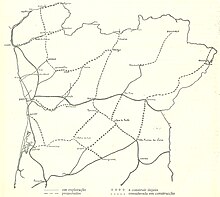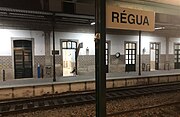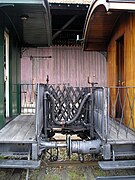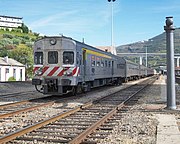|
Régua railway station41°9′30.57″N 7°47′0.82″W / 41.1584917°N 7.7835611°W
The Régua railway station previously known as Regoa railway station,[1][2] is a station on the Douro Line, which serves the town of Peso da Régua, in the District of Vila Real, in Portugal. It opened in 1879,[3] and served as a junction point with the Corgo Line, which operated between 1906[4] and 2009.[5][6] Overall information Location and accessThe station is located in the town of Peso da Régua, with access by the Largo da estação (Square of the station).[7][8] DesignBy January 2011, the station had a total of four lanes, measuring 379, 438, 350 and 319 m long, the platforms are 255 and 216 m wide, and 35 cm high.[9] Since October 2004, diesel fueling maneuvers can be carried out, and the station also has a public information system.[10] The passenger building is located on the south side of the road (right side going up towards Barca d'Alva). ServicesIn 1994, it was served by regional trains, for the transport of private cars, by the operator Comboios de Portugal.[11] History BackgroundBefore the construction of the Douro line, the regions surrounding the Douro river far from the Atlantic Ocean had a huge lack of communication with the rest of Portugal, with the river being the only way to receive or send any message, however, the voyage by boat was very complicated and took a lot of time, taking between 6 and 8 days to reach from Peso da Régua to Porto and vice-versa.[12] By the late 1880s, the famous ethnographer, José Leite de Vasconcelos, took a trip from Peso da Régua to Miranda do Douro that took 5 days.[13] InaugurationThe station was inaugurated on 15 July 1879, as a provisory station of the Douro line. Connection to Ferrão railway station, opened on 4 Abril 1880.[3] 20th centuryConnection to the Corgo lineStill in the 19th century, the German businessman Maximilian Schreck was authorized to build Horsecar railway lines between Vila Real, Régua, Lamego and Viseu.[14] A decree of February 18, 1903 states that attempts to build a railway between Régua and the border with Spain were being made.[15] In September 1905, a plan for expanding this station had already been prepared and presented to the Superior Council of Public Works, in order to accommodate both the Corgo Line, then under construction, and the planned Linha de Lamego.[1] The first section of the Corgo Line, between Régua and Vila Real, was opened to exploration on May 12, 1906.[4][16] In 1913, stagecoach service from Régua station to Lamego and Moimenta da Beira started.[17] In 1919, circulation on the section between Vila Real and Régua was temporarily suspended, due to the monarchic incursions happening in northern Portugal.[18] Enlargement Due to being the junction point of two separate railway lines [19] and an important road junction, the town of Régua has become a major communications center between the regions of Beira and Trás-os-Montes.[20] The station itself became an important Port wine transporter,[21][22] still, the station did not have the conditions to meet the traffic requirements, but it could not be enlarged due to the reduced space available, so it was decided to expand the then Godim halt (modern Godim railway station) instead, located near Régua.[23] On that same year, Régua station was partially repaired by the Portuguese Railway Company.[24] In April 1935, those expansions were almost done, that included sleeping quarters for the construction workers.[25][26] A decree from November 18, 1911 modified the rules for transporting Port wine on the Douro line. The wine that was transported by train to Barqueiros, Rede and Moledo was to be verified at a post in Barqueiros, but the rest was to be verified at Régua.[27] Plan for the Complementary railway network North of the Mondego River, enacted in 1900. In addition to the Corgo Line, a line from Régua to Vila Franca das Naves was also planned. Planned connections to other linesIn 1885, a railway link between Viseu and Chaves was planned, but it was never completed due to the considerable difficulties that would be encountered in its construction; therefore, two alternatives were proposed, with the military authorities supporting the line from Régua to Viseu via Lamego.[28] However, Régua was unable to support the junction of the broad gauge railway, and the problem of building on very difficult terrain remained, so a commission formed in 1927 to study and sketch a plan for the railway network north of the Douro river proposed the installation of two narrow gauge lines, one from Régua to Lamego, and the other from this town to São Pedro do Sul railway station, passing through Castro Daire.[28] These two lines were included in the General Railway Network Plan, a document made official by Decree number 18190 of March 28, 1930, and the Lamego line was planned to reach Pinhel, passing through Vila Franca das Naves.[28][29] A rail link between Régua and Vila Franca das Naved had already been presented, on a narrow gauge, by the Plan for the Complementary Network to the North of the Mondego, approved by a decree of 15 February 1900.[28]  ModernizationIn 1996, it was expected that the installation of electronic signaling would be extended to Régua, within the scope of the Porto Junction Railway Cabinet project.[30] 21st CenturyThe section of the Corgo line between Régua and Vila Real was closed by the National Railway Network on 25 March 2009.[5][6] In 2016, the entire railway infrastructure on dual gauge was dismantled between the Régua railway station and Corgo, which provided the connection between the trunk of the Corgo line and the maintenance, manoeuvring and commercial (passenger and freight) facilities in Régua, thus making it impossible to reopen the operation in the future on Iberian-gauge railways.[31] Literary referencesThe writer Horacel Lopes described the station and the people of Régua, when going on a trip through the Douro line in the 1950s:
GalleryStation of Régua
See also
References
Bibliography
Wikimedia Commons has media related to Régua railway station. External links
|
||||||||||||||||||||||||||||||||||||||||||||||||||||||||||
Portal di Ensiklopedia Dunia













